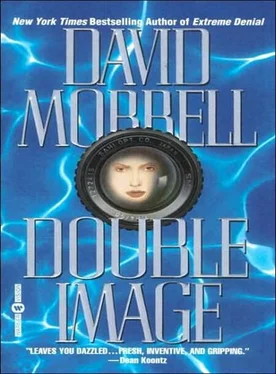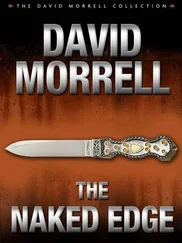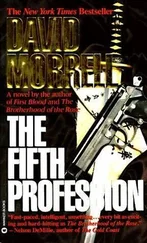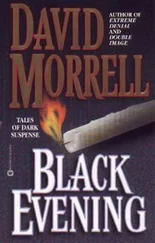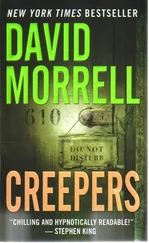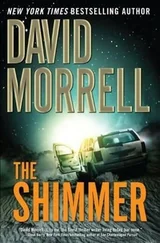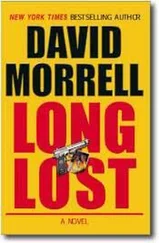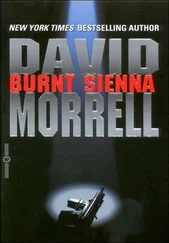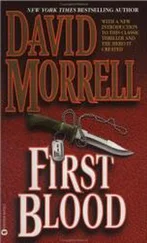If he had been preparing prints that were intended to be displayed, he would have done tests to determine the ideal length of time to expose the light-sensitive paper to the negative’s enlarged image, using trial and error to achieve the perfect density of detail and contrast of lights and darks. But these prints were important only for their information, not their aesthetic appeal. He needed to get them done as soon as possible, so he didn’t care about perfection, only whether the faces in the crowd were clear enough for Tash to be able to recognize any of them.
His experience with developing the previous prints had taught him that twenty seconds was an effective length of time to let the negative’s projected image touch the paper. The instant the timer clicked, the enlarger lamp turned off automatically. He removed the paper and set it where the only illumination that could reach it would be from the dim amber safelight. When he had exposed half a dozen sheets of paper, he took them to the developing tray, set them in the solution, and gently agitated the tray, rotating the sheets, developing them evenly.
The magic happened. Feeling a surge of anticipation, Coltrane studied them, as he had the earlier prints. During his fifteen years as a professional photographer, he had trained himself to have a keen visual memory, so he could easily recall details from earlier prints. But now his surge of anticipation changed to a sinking feeling of disappointment, for he still had not seen any faces that recurred in various locations. His pride made him hope that he wouldn’t have to admit to Tash that his plan had been a failure.
To make matters worse, the six prints in the developing tray had something wrong with them: The faces in the bottom-right corner of each print were overexposed, too dark to be distinguished. The faces in the rest of the area were perfectly acceptable, however. That contrast told him that although twenty seconds of exposure to the enlarger’s light was sufficient for most of the area in these prints, their bottom-right corners needed only fifteen seconds.
The prints weren’t usable. Muttering an expletive, he shoved them into a waste can and returned to the enlarger. He prepared to reexpose sheets of paper to the six negatives. For each one, he again set the timer for twenty seconds. But for this set of prints, when the timer reached fifteen seconds, he slowly waved his right hand between the paper and the negative, preventing the enlarger lamp from projecting onto the bottom-right corner of each print for the final five seconds. The movement of his hand reminded him of a magician’s gesture, an apt comparison because he was, after all, performing darkroom magic. By lessening the exposure time on the lower-right corners, he was able to enhance that area and bring out details.
When the sheets were finally exposed, he set them into the developing tray. But this time when the images came to life, he opened his mouth in shock. The previously indistinct lower-right corners were now vivid. As at the Beverly Center, he had taken these shots from an upper level, aiming down at the crowd. On the first print in the sequence, he found himself staring at a man with a 35-mm camera raised to his face, aiming in the direction of where Tash and her bodyguards approached her store. The camera was a mask, preventing Coltrane from noting the man’s features. The salt-and-pepper hair was an indication of middle age. That and the man’s somewhat-hefty build were the only identifiers.
Feeling as if something sharp was caught in his throat, Coltrane turned to the next print in the sequence and saw that the man had pivoted slightly to the right. His camera remaining at eye level, his finger pressing the shutter button, he was taking a photograph of Tash as she walked along. The new angle of his mostly hidden face revealed a thick neck and the suggestion of a puffy cheek. Coltrane turned to the third print in the series, where the man had pivoted more to the right, continuing to take photographs of Tash. From this angle, Coltrane saw a hint of a jowl. He told himself that he had to be wrong, that his imagination was deceiving him. Hurrying, he flipped through the final three prints in the sequence and saw in stop action the man lower his camera to his chin, to his neck, to his chest, never removing his intense gaze from where Tash was walking. The man’s profiled face was now fully in the open, and Coltrane felt nauseated as he was forced to admit that he hadn’t been wrong, that his imagination hadn’t deceived him. The man was Duncan Reynolds.
WHEN THE PHONE RANG, Coltrane had trouble getting his muscles to work. Only after two more rings was he able to avert his eyes from the prints and pick up the phone. Concerned that Jennifer might have broken her word and decided to call, he kept his voice neutral, or tried to. The stress of having identified Duncan Reynolds made him hoarse. “Hello.”
“Not very enthusiastic.” Tash sounded mischievous. “I thought you’d be a little more pleased to hear from me.” Her tone was wonderfully sonorous.
“‘ Pleased’ is an understatement.”
“Did I wake you?”
“No. I’ve been working.” Coltrane frowned toward the prints. He continued to strain to adjust to what he had discovered.
“I’m sorry I took so long. I didn’t want to phone you until after I talked to Carl, but I’ve been ringing his number for the past hour and all I get is his answering machine.”
“That’s because he’s probably in a car up the street from me, watching my house.”
“You’re kidding.”
“ Someone’s in a car up the street. It looks like the kind he drives.”
“Jesus,” Tash said. “I guess we were right to have me go home instead of to your place.”
“Maybe not. This time, he wouldn’t be catching me by surprise. Maybe I should go out there and-”
“No, there doesn’t have to be more trouble,” Tash said. “I think I can get him to calm down. I just need a chance to talk to him and make him understand that he got the wrong idea.”
“That’s something I’d like to understand, too,” Coltrane said. “What wrong idea are you talking about?”
“I promised to tell you, and I’m going to.”
“Then how about now?”
“No. Not like this. Not over the phone. I need to see your eyes. I need to make sure that you understand.”
“It’s that bad?”
“There’s nothing bad at all. But this is going to take awhile, and I remembered what you said about not using the cellular phone. Lyle and the state trooper are still with me. I had them drive me to a pay phone at a gas station on the Pacific Coast Highway. I’m not exactly where I can talk about this.”
“Tomorrow?”
“Yes. That’s another reason I’m calling. Do you have anything you can’t get away from for the next few days?”
“Only from seeing you.”
She didn’t say anything for a moment. “That gave me shivers.”
“The good kind, I hope.”
“In the right places. Can you meet me tomorrow morning at LAX?”
“LAX?” he asked in surprise.
“At the Delta counter? Nine-fifteen? That ought to give us enough time to buy our tickets and catch a ten-ten flight.”
“To where ?”
“Acapulco. The estate I inherited. I can’t bear looking over my shoulder any longer. I want to get away to where no one knows who we are. Where no one can bother us – not Carl, not the creep who’s after me, nobody. Where it’s just the two of us. Where we can talk and swim and lie on the beach.”
“Sounds good.”
“Do other things.”
“Sounds better.”
“You’ll go?”
“Twist my arm.”
Tash laughed.
“I like it when you laugh,” Coltrane said.
Читать дальше
